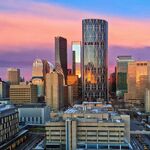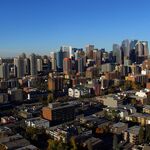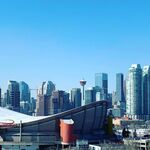Agreed on the yard size. Most people need only enough space for their BBQ and some chairs, a few flower pots etc.. I lived in a townhouse when I was a kid, and we had a small yard with the garage taking up 2/3rds. We had a deck that was probably around 15' X 15' and that took up most of the rest of the yard. The front yard had grass area that was bigger, but was never used. Most people can get by quite easily with a 15' X 15' yard space. I realize most of the new rowhomes might have smaller yard spaces, but point being people can make use of small outdoor spaces, just have to use them in an efficient way.I see people leaving their units and going to nearby parks to play, this age of neighbourhood actually have a decent amount of parks so it is possible to send kids off to play in the them. Not having a yard also means no maintenance, there are some cost and time benefits to that.
Take this small rowhome development on 10th St NW. Probably due to setbacks, they have a patch of grass out front that will never, ever get used. Basically a waste of space. Put that in the back and you turn it into a deck and you have a nice outdoor living space, rather than just a yard. Lately and going forward the trend is for smaller yards and the key is to think of them as an outdoor living space instead of a yard. The closest park makes a good 'yard' space for kids and pets.
In this case the developer was able to put in roof top decks which function as good or better than a typical yard space.




